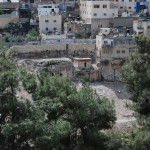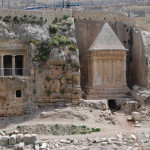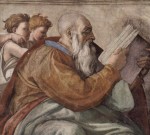Jerusalem. Tombs of the Kidron Valley. Part three
If one goes straight forward from the tombs of Absalom and Jehoshaphat in the direction of the Temple Mount, your eyes will run across three more burial structures; the first structure has columns – it is the Tomb of the Sons of Hezir. Next to the Tomb of the Sons of Hezir is another tomb, where according to the legend prophet Zechariah was buried. And further away, far from the first three tombs, there is the so-called Monolith at Siloam, or the Tomb of Pharaoh’s Daughter.
On the right of Absalom’s tomb and Jehoshaphat’s tomb there is a tomb with two columns hewn in the rock that mark out its entrance. This is the Tomb of the Sons of Hezir (Tomb of Benei Hezir), which was named so not according to the tradition in this case, but according to the facts, established by archaeology. Above the columns, an inscription in Hebrew was discovered on the architrave1 saying, “This is the grave of Eliezer, Hania, Yoazar, Yehuda, Shimon, Yochanan Benei (sons of) Yosef Ben (son of) Oved Yosef and Elazar Benei (sons of) Hania, priests of the Hezir family.” The priestly family of Hezir is mentioned in 1 Chronicles (1 Chronicles 24:15), and in the book of Nehemiah (Nehemiah 10:20). The Greek style of the columns indicates that they were cut in the Hasmonean times. People commonly referred to this tomb as “The House of the Free,” or “House of the Lepers” and believed it was a refuge place of king Uzziah or Azariah (769-740), when he suffered from leprosy; as it says in the Bible, “The Lord afflicted the king with leprosy until the day he died, and he lived in a separate house. Jotham the king’s son had charge of the palace and governed the people of the land” (2 Kings 15:5). The legend says, ” Why is it called the House of the Free? – because Uzziah was free from his kingship here. For kingship is a job, and the king has to bear all the burdens of the people.”

Monolith of Siloam, or Tomb of Pharaoh’s Daughter (cubic structure with an entrance, below which you can see the arched vault)
Architrave1 – is an architectural term, which has three meanings. First of all, architrave, or architrave lintel, is any straight beam covering a span between columns, pillars, or posts (in windows or doors); secondly, it is the lower part of the entablature, which directly rests on the column capitals; and thirdly, it is one of the kinds of tiles, which is used for facing Dutch ovens (Encyclopaedic dictionary of Brockhauz and Efron).
According to an Armenian tradition, James, the Lord’s brother, was buried in this tomb, before his remains were reinterred under the main altar of the Church of Saint James in Jerusalem’s Armenian quarter. According to the tradition, after Jesus was crucified, James out of fear before the Romans hid in this cave, and here Jesus appeared to him, as Apostle Paul said, “Then he appeared to James, then to all the apostles, and last of all he appeared to me also, as to one abnormally born.” (1 Corinthians 15:7-8).
Near the Tomb of the Sons of Hezir, there is another tomb, wholly cut from the monolith, which is commonly referred to as the Tomb of Zechariah.
Zechariah (meaning from Hebrew “remembered by God”) is a name that is often mentioned in the Bible. According to the Jewish tradition, this tomb belongs to the Jewish high priest Zechariah, Jehoiada ‘s son, killed on the Temple Mount at the commandment of the wicked king Joash, “Then the Spirit of God came on Zechariah son of Jehoiada the priest. He stood before the people and said, “This is what God says: ‘Why do you disobey the Lord’s commands? You will not prosper. Because you have forsaken the Lord, He has forsaken you.’” But they plotted against him, and by order of the king they stoned him to death in the courtyard of the Lord’s temple. King Joash did not remember the kindness Zechariah’s father Jehoiada had shown him but killed his son, who said as he lay dying, “May the Lord see this and call you to account.”” (2 Chronicles 24:20-22).
The first Jew, who identified this tomb with the grave of Zechariah, was Menahem ha-Hebroni (1215). Some Jewish exegetes see in the killing of Zechariah the reason of the destruction of the First Temple. They counted seven transgressions, committed by the Jews who killed Zechariah: 1 – murdering a priest; 2 – murdering a prophet; 3 – murdering a judge; 4 – shedding the innocent blood; 5 – defiling the Temple’s precincts; 6 – committing a crime on Sabbath (day of rest, Saturday); 7 – committing a murder during the feast of Yom Kippur (Judgement day). Rabbi Joshua ben Qorha narrates,
“A certain elder from the people of Jerusalem told me, “In this valley Nebuzaradan, chief slaughterer, killed a great multitude of people, and their blood went and mixed with that of Zechariah. The blood of Zechariah was boiling and springing up. “What is this?” – asked Nebuzaradan, – “It is the blood of the sacrifices, that has been poured out,” they said to him. He told them to bring animal blood, and compared it, and it was altogether not like that blood. He said to them, “Explain it to me, and if not, I shall comb your flesh with iron combs.” They said to him, “What shall we tell you? This one was a prophet among us, and he rebuked us for our sins, and we ganged up against him and killed him. And lo, for many years his blood has not come to rest.” He said to them, “I shall be the one to appease him.” He brought the great Sanhedrin and the lesser Sanhedrin and killed them over him, but Zechariah’s blood did not come to rest. He brought young men and women, but the blood did not come to rest. He brought schoolchildren and killed them over him, but still the blood did not come to rest. He said, “Zechariah, Zechariah, I have destroyed the best of them. Do you want me to kill them all?” When he said this to him, forthwith the blood came to rest. He said to himself, “Now if because of a single taken life the Lord’s wrath in the form of this boiling blood would not come to rest for so long, what should happen after I have taken so many lives? Nebuzaradan fled from that place, sent his instruction to his household, and then converted to the Law of the One God.”
Some Christian exegetes2 believe that Zechariah son of Berechiah is not the same person as Zechariah son of Jehoiada, and he is no one else but priest Zechariah – the father of John the Baptist, who was also killed by Herod “between the temple and the altar,” which gives them the ground to attribute this tomb to him. Others believe that Jesus meant Zechariah – one of the twelve prophets, the author of the Book of Zechariah, but the Bible does not mention anywhere that he was killed. The traditional tomb of this prophet is located almost on the very top of the Mount of Olives, above the Dominus Flevit Church, on the right side of the walkway, in a large labyrinth of ancient underground burials, including those of prophets Haggai and Malachi. This place is very interesting. The site belongs to the Jews and it is open for visitors. But more likely Jesus meant Zechariah son of Jehoiada.
2Exegetes are theologians, who engage in interpreting Biblical texts.
There was one more Zechariah son of Berechiah, who was killed in the Temple, but it happened after the crucifixion of Jesus, during the Jewish war in 70 A.D. Josephus Flavius narrates this event, “And now these Zealots and Idumaeans were quite weary of simple massacre, so they had the audacity to set up mock trials and courts of justice for that purpose. They intended to have Zacharias, the son of Baris, one of the most eminent of the citizens, slain. What provoked them against him was that hatred of wickedness and love of liberty which were so eminent in him; he was also a rich man, so that by taking him off, they did not only hope to seize his effects, but also to get rid of a man that had great power to destroy them. So they called together, by a public proclamation, seventy of the principal men of the populace, for a show trial, as if they were real judges, although they had no proper authority. In front of these citizens Zacharias was accused of a design to betray their city to the Romans and to have traitorously sent to Vespasian for that purpose. Now there appeared no proof or sign of what he was accused; but they affirmed themselves that they were well persuaded that so it was, and desired that such their affirmation might be taken for sufficient evidence. Now when Zacharias clearly saw that there was no way remaining for his escape from them, as having been treacherously called before them and imprisoned, but with no intention of a legal trial, he took great liberty of speech in that despair of life he was under. Accordingly he stood up, and laughed at their pretended accusation, and in a few words confuted the crimes laid to his charge; after which he turned his speech to his accusers, and went over distinctly all their transgressions of the Law, and made heavy lamentations upon the confusion they had brought public affairs into. In the meantime the Zealots grew tumultuous, and could scarcely refrain from drawing their swords, although they designed to preserve the appearance and show of judicature to the end. They were also desirous, on other accounts, to try the judges, whether they would be mindful of what was just at their own peril. Now the seventy judges brought in their verdict, that the person accused was not guilty — choosing rather to die themselves with him, than to have his death laid at their doors. Hereupon there arose a great clamour by the Zealots upon his acquittal, and they were all indignant at the judges for not having understood that the authority that was given them was but in jest. So two of the boldest of them fell upon Zacharias in the middle of the Temple, and slew him. And as he fell down dead they bantered him, and said, “Now you have our verdict also, and a surer release.” They then threw him down out of the Temple into the valley beneath it. Moreover, they struck the judges with the backs of their swords, by way of abuse, and thrust them out of the court of the temple, and spared their lives with no other design than that, when they were dispersed among the people in the city, they might become their messengers, to let them know they were no better than slaves.”
In 1185, a Greek pilgrim John Phocas described this monument in the following way, “Immediately after the Gethsemane, at an arrow’s shot length, there is a so-called Kukum – the building, built on a rock in the shape of a square. Its height, in my opinion, is above two doubles (put on top of one another), and, like a shape of a pyramid, it is thinning upward, in which monk Evir, having confined himself, is working out his salvation. Further up, there is a large mountain range with various artificial grottoes, which are named after the Virgin and are inhabited by a few Orthodox, and by a larger number of Armenian and Jacobite monks.” John Phocas saw the tomb of Zechariah (priest) in no other place but in the very cave of the rock with the mosque Dome of the Rock on it, “In this cave prophet Zechariah is laid, who, according to the Gospel, was killed by the Jews between the sanctuary and the altar.” As for the burial site of Zechariah, the father of John the Baptist, in John Phoca’s opinion, it is located in Sebaste, close to the site where John the Forerunner was beheaded, and an altar is placed over it, “On the right of the altar is a coffin in which is preserved the body of Saint Zacharias, the father of the Forerunner. And on the left side is a second coffin in which lies the body of Saint Elizabeth his mother.”
And even further away from the foregoing burials is one more cult monument called the Monolith of Siloam, or the Tomb of pharaoh’s daughter. At first sight, this monument looks like one of the houses of the neighbouring village Silwan. But at a closer look, you notice the absence of windows. This tomb attracted the attention of the French archaeologist Louis Félicien de Saulcy, who wrongly identified it with a mausoleum, built by King Solomon for his Egyptian wife, pharaoh’s daughter. The Bible mentions on a number of occasions that Solomon married pharaoh’s daughter and received the city of Gezer as the bride’s dowry (1 Kings 3:1; 7:8; 9:16, 24; 11:1). It took place somewhere in the beginning of his reign, approximately in 970-960 B.C., which matches the rule of pharaoh Siamun (979-960 B.C.) from the 21st dynasty.
Actually, the sepulchre was built in the 8th century B. C. For this purpose the top of the adjoining rock was cut off. Then, on a stone cube, a pyramid was placed, like in the tomb of Zechariah. In the following centuries, the pyramid on the tomb significantly suffered, because very close to it was a functioning quarry. A Greek monk who came to dwell in this tomb also did a great damage to it. He decided to enlarge the entrance by destroying a part of the wall, which contained an inscription in Hebrew. Only two letters have survived from this inscription until now. In the 19th century, a little below the tomb, an arch was added, which made the monument more accessible.
This article uses the materials from the book by A. P. Kondrashov, Who is Who in the Bible: Popular Encyclopaedic Dictionary, Moscow, RIPOLL Classic, 2004.


